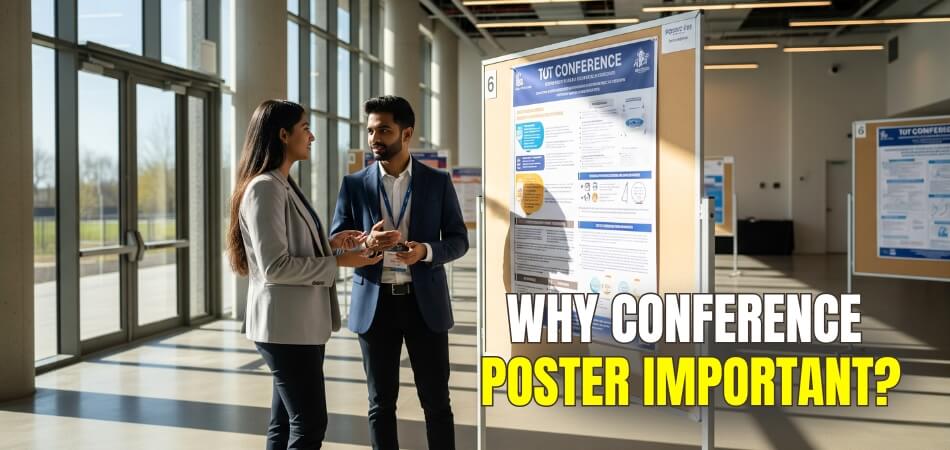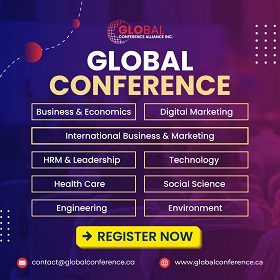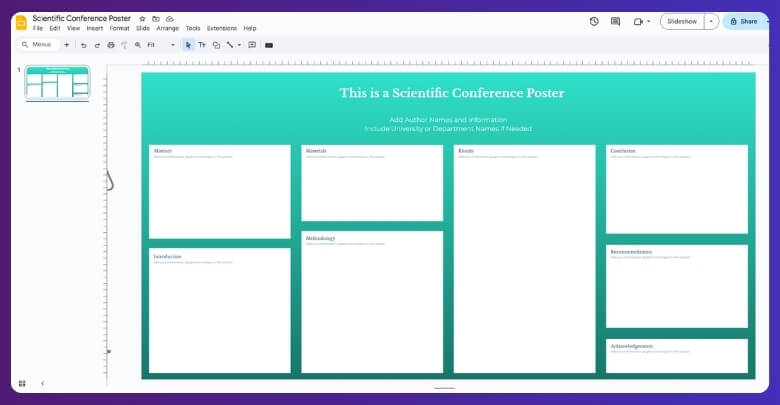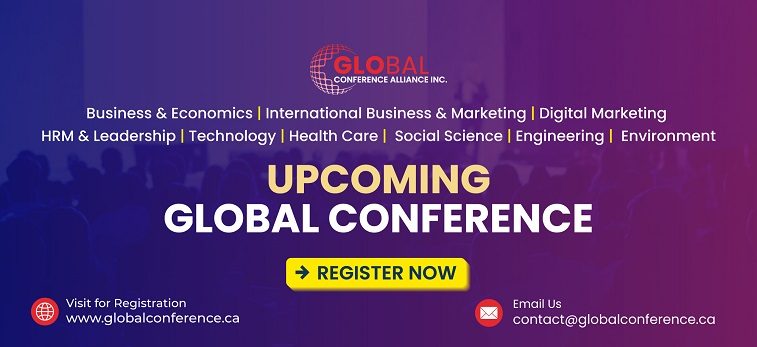Conference posters often catch your eye with bold colors, short titles, and clear layouts pinned on big display boards. They’re not just decorations—they’re tools to share ideas fast in research settings. That’s why many people start to wonder why conference poster important?
A conference poster is important because it simplifies research, sparks conversation, and helps you build skills and connections. It lets everyone share ideas, get feedback, and learn fast. Posters also give new researchers a fair chance to stand out and grow.
If you’ve ever paused to read a poster or thought about creating one, you’re likely interested in learning more. This article has everything you need to know about conference posters—from their value to design tips—so keep reading and find the answers you’re looking for.
Why Conference Poster Important?
Posters are more than just printed research; they’re a chance to speak without speaking. Whether you’re new to academic events or curious about how they work, this breakdown shows why posters are worth paying attention to. Let’s take a closer look.
Easy to Understand
Most people don’t want to read pages of research at an event. Posters take complex ideas and turn them into simple, eye-catching layouts. They use titles, graphs, and short points to help others understand your topic fast. If you’re thinking about going to any upcoming conferences in Canada, the USA, or any other country, these posters can make it easier for you to grasp new topics and connect with the research without feeling overwhelmed or confused.
Talk With Experts
A great part of poster sessions is that you get to speak directly with the person who made the poster. It’s more relaxed than a big speech. You can ask questions anytime and get clear, real answers. These chats often turn into longer talks, tips, or even new ideas. Sometimes, experts give advice right on the spot, helping you see things differently or fix something in your own work.
Build Useful Skills
Speaking in public isn’t easy for everyone. With a poster, you get to explain your ideas face-to-face in a small setting, which helps you feel more confident over time. Making the poster also teaches you how to share your thoughts clearly using images and short texts. Both of these skills are useful later in work or school, especially when you need to share your ideas quickly and clearly.
Meet New People
Posters pull in people who are interested in your topic. This gives you a chance to meet others who care about the same things you do. These small chats can turn into friendships, school opportunities, or even work offers. Sometimes people remember your name just because they liked your poster. It’s a simple way to stand out and make your mark without having to speak to a big room.
Share New Ideas
Not all research is finished, and that’s okay. Posters are a great way to share something that’s still in progress. You don’t need to have all the answers yet. People might give feedback, suggest changes, or offer help. This can make your work better before it’s final. It also lets others know what you’re working on, which can lead to future support, ideas, or even partnerships.
Learn in Less Time
You don’t need to sit through long talks to learn something useful. Posters help you take in lots of new ideas just by walking around. You can learn a lot by reading a few points or asking quick questions. If you’re short on time but still want to get good value from an event, poster sessions are one of the easiest ways to learn fast without feeling stuck.
Open for Everyone
Unlike long lectures that only a few get picked for, poster sessions give almost everyone a chance to show their work. It doesn’t matter if you’re just starting or already well-known. If you’ve got something to share, a poster gives you a space to do it. This makes things feel more fair and gives more people a shot at being seen, heard, and supported by others in the field.
Posters may seem small, but they leave a strong impression. They help people connect, learn, and share ideas in a way that feels real and easy. You don’t need fancy tools, just a good idea and a clear way to show it. If you get the chance, don’t skip the poster section.
How Does a Poster Presentation Differ From an Oral Presentation at a Conference?
At most conferences, people share their ideas through posters or live talks. Each type has its own style and way of communication. Some prefer speaking in front of a crowd, while others enjoy quiet one-on-one chats. Knowing the difference can help you choose what fits you best.
| Feature | Poster Presentation | Oral Presentation |
| Presentation Style | One-on-one or small group discussions | Speaking to a full audience in a room |
| Time Limit | Flexible timing; it depends on the visitor’s interest | Fixed time (usually 10–15 minutes) per speaker |
| Visual Format | Large printed poster with short text and visuals | Slide-based presentation sometimes includes animations |
| Interaction | More personal and ongoing throughout the session | Usually limited to Q&A after the talk |
| Nervousness Level | Less pressure, relaxed and informal chats | More pressure due to stage presence |
| Feedback Type | Instant feedback and open discussion | Mostly comes at the end, after the talk finishes |
| Movement and Space | Stand near the poster, move freely while talking | Stand in front, usually behind a podium |
Both poster and oral presentations have their own strengths. Posters give you more time and personal interaction. Oral talks let you reach a larger group at once. Picking the right one depends on how you like to share your work.
What Are the Key Elements of an Effective Conference Poster?
Some posters get a lot of attention, while others are ignored. A big reason is how well the poster is planned and designed. If the layout looks messy, people won’t stop to read it. Want to make a poster that actually works? Keep reading for simple tips.
Clear Main Message
A poster’s purpose should be clear to viewers within seconds. Use a strong title, a simple research question, and key findings at the top. Don’t use too much background information up front—get straight to the point. Layout helps you present your research clearly. Using an effective poster structure for conference settings helps viewers quickly grasp your main points. It also guides their attention naturally from introduction to results, which is especially important in busy poster sessions.
Organized Layout
People usually read posters from top to bottom and left to right. Set up your sections in that order to keep everything flowing smoothly. Keep space between sections so nothing feels cramped. Use boxes or lines to guide the eyes. Even the size of the text matters—titles should be larger than body text. If the layout looks neat, more people will stop to read your work and understand it better.
Visual Balance
Too much text can make a poster feel heavy. That’s why a good balance between words and visuals matters. Use graphs, charts, and images to break up the space and explain data. Each visual should have a short caption so people know what they’re looking at. Make sure nothing is too small or too packed. A well-balanced poster feels easier to read, which keeps people interested longer.
Simple Language
A good poster avoids complicated words. Instead, it focuses on simple, direct language that anyone can follow. This helps people from different backgrounds understand your work. Use short paragraphs or bullet points to make the information easier to digest. Also, avoid using technical terms too often unless they’re clearly explained. Keeping things simple doesn’t make your work look weak—it actually makes it more powerful and clear.
Consistent Design
Colors, fonts, and text sizes should look the same across the poster. This makes your work look clean and professional. Don’t use too many colors—two or three are enough. Choose a readable font, and avoid fancy styles. Keep titles bold, section headings the same size, and body text uniform. These small design choices help the reader focus more on your research instead of being distracted by how the poster looks.
Every great poster tells a clear and easy story at a glance. It’s not about fancy words or heavy designs—it’s about being clear. If your layout and message are easy to follow, people will stay longer. A little planning goes a long way in making your poster stand out.
Are Poster Presentations Recognized in Academic Research Evaluations?
Poster presentations are often seen at conferences, usually displayed on big boards with colorful charts and short explanations. But how much do they really count in the world of academic research? Let’s take a closer look and break it down.
Academic Value
Posters do hold value in research, but not always the same as published papers. They are usually seen as early steps in sharing ideas. Reviewers may not rate them as highly as journals, but they still count, especially when listed on a CV. It shows you’ve been part of research events and shared your work publicly, which matters to many academic groups.
Proof of Work
Even if a poster isn’t a full paper, it proves that you’ve done real work. Making a good poster means you’ve studied a topic, found results, and shared them. This shows effort, planning, and understanding. When research groups look at your background, they notice this kind of work. It’s not just about what you discovered—it’s also about how you shared it with others.
Conference Presence
Presenting a poster means you’ve been accepted to take part in a research event. These events often have a review process, so getting chosen matters. It means someone looked at your idea and said yes, this is worth sharing. Being there also shows that you’re involved and active in your field, which can leave a good impression on people who make decisions later.
Feedback Opportunity
One big benefit of posters is that they lead to helpful feedback. When people stop by your poster and ask questions or give suggestions, you learn what to improve. This can make your research stronger for future work. In research evaluations, the effort to grow and improve based on feedback can sometimes count as much as the poster itself, depending on the review group.
Publication Chances
Some posters can lead to bigger things. If your topic gets attention, you might be invited to write a full paper or join a bigger study. This turns a simple poster into a published work over time. While the poster itself might not be highly ranked in evaluations, what comes after can be. It’s a starting point that opens up real academic chances.
Poster presentations might not carry the same weight as journal papers, but they still matter. They show that you’re involved, active, and willing to share your ideas. That effort is often recognized during evaluations. So yes, posters do count—just in their own way.
What Mistakes Should You Avoid When Designing a Conference Poster?
A conference poster might look simple at first, but designing one takes planning and smart choices. Colors, layout, and text all play a role in how your message is shared. Keep reading to avoid common mistakes and do it right.
Too Much Text
Readers shouldn’t feel like they’re reading a full paper. If your poster has long paragraphs, people may skip it. Use short sentences, bullet points, and space things out. Big chunks of text make the poster look crowded and tiring. Try using bold headers to break up the sections. This way, your key points stand out clearly without overwhelming anyone who stops by.
Unclear Flow
Posters need a clear path from one section to the next. Without a logical flow, readers might feel lost. Arrange your sections in a natural order—title, introduction, method, results, and so on. Academic conference posters often follow this structure to keep things clear. Many first-time presenters forget this when they make a poster for academic conference settings, focusing only on colors and titles instead of layout.
Small Fonts
If the font is too small, people won’t even try to read your work. It’s important that your text is big enough to see from a short distance. Choose simple, clear fonts like Arial or Calibri. Avoid fancy or cursive styles. Test your poster from a few steps away before printing. If you can’t read the key points easily, it needs to be fixed.
Missing Key Parts
Posters aren’t just about showing results—they’re about telling a full story. Skipping things like your objective or conclusion makes it hard for others to understand your message. Every poster should include the reason behind the work, how it was done, and what it found. Don’t assume people already know your topic. Give them all the parts they need to follow your work properly.
Poor Use of Space
A messy layout can make even great research look confusing. If images are too big and text is squeezed into corners, it hurts your message. Use space wisely—don’t overfill every inch. Let your poster breathe. Place things in boxes or columns, and keep them aligned. This makes the design look neat and easy to follow, which helps others take your work more seriously.
A good poster doesn’t have to be perfect, but it should be clear, simple, and well-organized. When done right, it speaks for you even when you’re not standing next to it. Small mistakes can take away from big ideas. Keep it clean, focused, and easy to follow.
Commonly Asked Questions
Conference poster sessions aren’t just about hanging a printed sheet. There are many questions people have about how they work, why they matter, and what to expect. These FAQs will help you understand some key points not previously discussed. Let’s clarify why posters matter.
How Early Should You Arrive for a Poster Session?
It’s a good idea to come early so you can find your spot and set up without rushing. Arriving early also gives you time to walk around and see other posters. You might even get ideas by looking at how others set up their displays. Being early helps you feel calm and ready when visitors start coming by.
Can You Hand Out Materials at Your Poster?
Yes, you can bring small handouts like flyers or summaries of your research. These are helpful for people who want to remember their work later. Keep them short and easy to read. Make sure your contact information is included in case someone wants to follow up.
What Should You Wear for a Poster Presentation?
Dress neatly, like you would for a school presentation or a job interview. You don’t need to wear a suit, but you should look clean and confident. Simple clothes that help you feel comfortable are best. The way you look adds to how people remember your poster and your ideas.
How Do You Start Talking to Someone at Your Poster?
You can begin with a friendly smile and ask if they’d like a quick overview of your work. Most people will say yes, and then you can explain the key points. Keep your intro short, just enough to make them curious. Once they’re interested, they’ll ask more questions.
What If No One Stops at Your Poster?
It happens sometimes, and it’s okay. Use that time to look at other posters and talk to other presenters. You might even invite someone nearby to visit your poster. Don’t feel bad—it’s still a learning experience, and your work still matters.
Can You Add Personal Stories to Your Poster Talk?
Yes, if the story connects to your topic, it can help people understand it better. A short personal example makes your work feel more real. Just keep it short and clear. People often remember stories more than facts.
How Long Should You Talk at a Poster Session?
You should keep your main talk short, around 2–3 minutes. That gives people a quick idea of what your work is about. After that, you can answer questions or go deeper if they’re interested. Always be ready to adjust based on the person listening.
Do You Need to Stay the Whole Time During the Session?
Yes, you should stay by your poster for the full session. Visitors may come at different times, and you don’t want to miss them. It shows that you’re serious about your work. Leaving early could mean losing chances to share your ideas.
Can a Poster Presentation Be a Group Effort?
Yes, many posters are made by teams, especially for group projects. One person may present, or the whole group can take turns. Just make sure everyone knows the main points. Team posters often show strong teamwork and shared effort.
Is It Okay to Keep Your Poster After the Event?
Yes, most people take their posters home once the session ends. You can use it again or hang it in your room or school. Some people even take photos to share it online. Keeping your poster helps you remember what you did and what you learned.
Final Words
Posters do much more than hang on a wall—they help people share ideas quickly, clearly, and in a friendly way. They create space for learning, questions, and new connections without pressure. So, why conference poster important? Because they make research easy to understand, open to all, and helpful to both presenters and viewers.
If you’re planning to present, keep your message clear, layout clean, and language simple. Use colors that don’t distract and make your text readable from a distance. A good poster can leave a strong impact even with a few words. Best of luck with your conference poster—you’ve got this!








